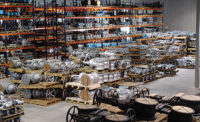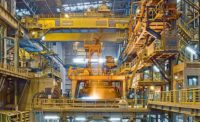PVF insiders provide mid-year industry report card

Wolseley Industrial Group Vice President Rob Braig sees the industrial PVF market heading in the right direction. “Growth in the industrial PVF market continues to slowly trend upward,” he says. “However, the growth rate is expected to accelerate into 2018.” Photo courtesy of Ferguson.

Numbers game: American Supply Association member industrial PVF distributors reported a 9.8% sales increase in May compared to May 2016. Photo courtesy of Ferguson.

“We see industrial PVF continuing on an upward trend,” says Kip Miller, president and CEO of Eastern Industrial Supplies. “Economies around the world appear to be a bit stronger and growing. Here at home, capacity utilization levels are rising across multiple verticals.” Photo courtesy of Ferguson.



One year ago in the Supply House Times annual mid-year pipe, valves and fittings outlook/forecast, the following comment was made by MRC Global President and CEO Andrew Lane.
“This is markedly one of the worst oil-and-gas downturns in history with global exploration and production spending down more than 45% in the last two years,” he said at the time.
A year later, the tone of the PVF industry has changed for the better. For the most part, distributors and manufacturers of PVF products are seeing upturns in business and are predicting more gains to be made in the near future, but still with a hint of trepidation mixed in.
Show us the numbers
How much better is the PVF segment of the industry? As an example, American Supply Association member industrial PVF distributors reported a median sales increase of 9.8% for the month of May compared to May 2016. And as of press time, PVF respondents to ASA’s Monthly Pulse survey reported a median sales increase of 6.8% calendar-year-to-date and the median increase for the trailing 12 months was 5.5%.
“We are very positive at this time,” says Howard Traeger, president of Miami-based industrial PVF distributor Traeger Brothers & Associates, which recently opened a branch in Houston. “We have experienced sustained growth during the last two quarters. We sell our products both domestically and internationally, and for the first time in many years we are seeing strong growth in all our markets and industries.”
Rob Braig, vice president at Wolseley Industrial Group, also sees an improving climate. “The industrial PVF market is growing stronger,” he says. “We expect overall growth over the next two years, especially in the project market, and maintenance, repair and operation spend in the chemical, power and refining segments. Bid work continues to be active and more competitive. Spending by major customers is more consistent and predicable than it was four years ago, but end users are more conservative when investing.”
Valve Manufacturers Association Chairman Jim White (Curtiss-Wright Individual Division Valve Group) notes VMA’s late January forecast was for low-single-digit growth for the first time since the market crashed. “We believe that forecast is holding,” White says. “Member responses to our monthly state-of-the-industry survey continue to show optimism.”
In that survey White notes 90% of respondents either are neutral or better in their feeling about the market, while just short of 40% fall into the optimistic/very optimistic category.
“VMA member companies serve various industries, each having their own dynamics,” he says. “In oil and gas, the mood is cautiously optimistic as we balance sustained lower oil prices (below $50 per barrel) and the resulting pressure on upstream capital spending with the stabilization of oil prices and inventories by the end of 2017 or early in 2018. There is more optimism in other areas such as chemical and industrial gases, resulting from favorable feedstock prices.”
Kip Miller, president and CEO of Greenville, S.C.-based Eastern Industrial Supplies and chairman of ASA’s Industrial Piping Division, says his company anticipates growth of 5-10%-plus year over year in the second half of 2017.
“We see industrial PVF continuing on an upward trend,” he says. “Economies around the world appear to be a bit stronger and growing. Here at home, capacity utilization levels are rising across multiple verticals.”
Miller attributes conditions to the improved health of the U.S. manufacturing sector. “Let us not forget the U.S. is a manufacturing dynamo,” he says. “In 2015, the U.S. was 24.5% of the worldwide GDP with China next at 15%. Housing is strong, which is an indicator of a healthy manufacturing sector. Manufacturing is benefiting from lower feedstock prices and with the emphasis our current administration is placing on U.S. jobs.”
Your neck of the woods
While there is an overall sense of market improvement, there is some variance depending on what part of the country one does business in. “I believe trends are flat in the Southeast,” says John Howe, CEO at Birmingham, Ala.-based American Pipe & Supply. “There seems to be a hesitancy currently to proceed with many large industrial projects.”
Joe Pro, president of industrial PVF fittings manufacturer Penn Machine adds: “The election and lack of progress on most initiatives has left many dollars on the sideline awaiting more clarity on direction.”
Todd Ford, president and CEO of Omaha, Neb.-based Central States Group, points to medical and data-center construction as areas of key growth in the Midwest. “Our customers have strong backlogs and seem optimistic about the balance of 2017 and the beginning of 2018,” he says.
Brian Tuohey, president of Windsor, Conn.-based The Collins Companies, sees improvement, but at a “lower percentile than originally forecast.”
“The post-election exuberance and confidence is waning with the inability of Congress to pass any significant legislation.” Tuohey adds he’s seeing necessary maintenance projects being funded, but larger capital projects being cancelled or delayed.
Further north, F.W. Webb Senior Vice President of Industrial Business Development Ernie Coutermarsh is seeing strong upticks in the company’s PVF endeavors. “We are bullish on the PVF sector,” he says. “Industries that are doing well are commercial construction with cranes in the air in the major urban areas of the Northeast. Our home base of Boston is seeing unprecedented investment.”
Coutermarsh says the food and beverage industry also has been fruitful for Webb, as has a growth in the use of thermoplastic piping systems and high-purity piping. The distributor also has benefitted from expanding into the waterworks vertical. “I believe the renewed emphasis on investing in what’s best for America is helping,” he says. “Our customers are confident. There is an unmistakable level of enthusiasm.”
Tom LaGuardia, vice president of sales and marketing at Milwaukee Valve, also is noticing positive commercial construction conditions. “We like the apparent rebound of the commercial construction market,” he says. “We see many opportunities, especially since candidates and elected leaders from both political parties made strong statements concerning the need for increased infrastructure spending over the next several years.”
Tim Fries, vice president of sales and marketing at Cincinnati-based Powell Valves, still sees some uncertainty in the marketplace. “Large capital projects seem to be moving much slower to the purchase phase of our process,” he says. “We had a record year in 2016 and currently are trending flat to slightly soft in 2017 vs. 2016. Our channel partners’ day-to-day business is strong, but we are missing the cap-ex spending. However, we are seeing the bid and planning activity at the EPC (energy, procurement and construction) beginning to pick up momentum.”
Gary Jackson, vice president of the PVF and PHCP divisions for the AD buying group, is noticing one telltale sign of forward-swinging momentum. “The best positive indicator right now is a stronger demand for PVF products. Projects are moving forward and wholesalers are seeing their local customers stay busy and develop backlogs. That covers most markets and most geographic areas.”
Several executives interviewed for this story say the continued labor shortage remains a great concern. Other topics to be watched, executives say, include low-cost country product being sold in the U.S., as well as the pending U.S. Commerce Department review of the Section 232 steel tariffs (determining the effect of steel imports on national security).
“That (Section 232) has everyone watching closely,” Pro says. “Imported products could become more expensive and any increased cost put through the manufacturing process will lead to higher end-use costs. This could create additional drag on the economy as consumer goods become more expensive.”
But as a whole, executives interviewed predict conditions will continue to improve in the PVF industry. “Since 2008, an up year of sales has been followed by a down year,” Traeger says. “We have not seen two years in a row where we have experienced growth. However, I am optimistic this might be the time.”
Braig adds: “Growth in the industrial PVF market continues to slowly trend upward. However, the growth rate is expected to accelerate into 2018. The increasing number of oil rigs in addition to the aging infrastructure and increased manufacturing will provide opportunities for growth in 2017 and 2018.”
This article was originally titled “What a difference a year makes” in the August 2017 print edition of Supply House Times.
Looking for a reprint of this article?
From high-res PDFs to custom plaques, order your copy today!












